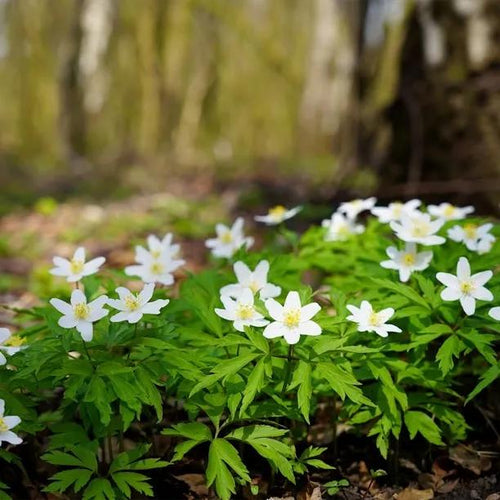Wood Anemone Rhizomes
Anemone nemorosa is the wood anemone of British woodlands. This is a beautifully delicate plant, often forming a thick carpet in deciduous woodland in spring, where it associates well with bluebells, aconites and snowdrops. Browse all of our garden bulbs.
Few scenes signal the arrival of spring more than that of a woodland floor covered with a mass of Anemones in full bloom. It may look delicate, but the pretty wood anemone is as tough and persistent as they come and is one of the very few plants to thrive in beech woods. As well as handling shady areas, it's perfectly happy in sunny spots, although it much prefers moist soil, rich in organic matter.
Our Anemone nemorosa bulbs in the green are lifted by us and promptly replanted by you in Spring only. As they're in growth, they're easy to see, and so are perfect for planting exactly where you want them to be.
Features
- Plant height: 4-6 inches
- Flower diameter: 3/4 inch, with 6-8 petal segments each, one flower per stem sitting above its leaves
- The flowers, star-shaped, are usually white in colour, but may be pinkish, lilac or occasionally blue, and are often tinged pink on the back of the flower head. The petals surround a burst of yellow stamens above a green centre.
- This wild variety doesn't have an RHS Award of Garden Merit itself, but four of its (very similar) named cultivars do, so you could say that it's an honorary holder of the award.
- Plant in autumn, in well drained humus rich soil, 6 inches apart, 3-4 inches deep. Before planting soak the rhizomes in water overnight, adding a good helping of well rotted manure or compost to the soil.
- Flowers from February through to May, at which time it dies down and remains dormant through the summer.
- Musky smell.
Once planted, there is little the Wood Anemone needs apart from the occasional top dressing of leaf mould or compost when the plants are dormant. Watering is only needed in unusually dry conditions.
History & Trivia
Other common names include Thimbleweed, Crowfoot, Windflower, Moonflower and Lady's Nightcap.
Although pure and angelic looking, this enchanting little flower has a dark side and is considered unlucky in some parts of the world, probably due to the fact it's poisonous to humans and animals.
But it's a firm favourite with English gardener, TV presenter and writer Sarah Raven, who uses them in her garden to "join up the dots and colour in the background between various dominant, showy bulbs".
These white little stars are a member of the buttercup family and are great providers of pollen and nectar for our precious bumble and honey bees.
All of our wild plant varieties are cultivated, not taken from woodland.

 Secure, One-Tap Checkout
Secure, One-Tap Checkout
 Hand Picked, Delivered to Your Door!
Hand Picked, Delivered to Your Door! 1 Year Bareroot Guarantee
1 Year Bareroot Guarantee

